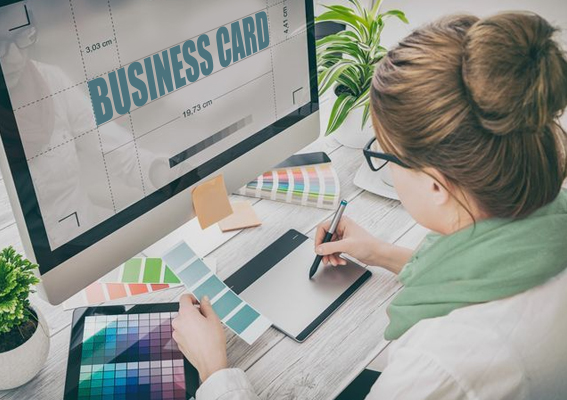You probably weren’t thinking about business cards when you decided to start a home business. They got pushed aside by other things like finding clients and jumping through legal hoops.
But now, it’s time to shine the spotlight on this marketing tool. It has the power to build business relationships, advertise your brand, engage clients’ emotions—and after all that, it still fits into the pocket of your jeans.
You’d be crazy to miss out on a marketing opportunity like that. But before you jump on the business card bandwagon, it’s important to understand why you’re doing it. You need to know how business cards can help you, how to make one for yourself, and where to use it.
How business cards help you
There are many reasons business cards are effective for networking, with the main ones being that they’re convenient and memorable. It’s no trouble at all to whip out a card and hand it to a connection. And since business cards are tangible, they’re easier for people to remember than digitally stored contact info that doesn’t make a sensory impression.
They can also work as mini billboards. If you want to really advertise your merchandise, you can include a product photo on one side of your business card. Clients love imagery, and it helps them connect your name with what you do. If you have a storefront, add a map or a photo of your shop to help clients find it.
A creative business card design will engage your clients’ imaginations. One that’s humorous or thought-provoking will help customers connect emotionally with your brand, because they will remember the way they felt when you gave them the card. It’s tough to put a price tag on that kind of advertising.
How to create a business card design
When it comes to making a business card, you’ve got lots of options. There are pros and cons to each, so it’s important to determine which option will be the most effective for your business.
A high-quality name card will help you look professional; fun design features should also be considered so you can stand out among other brands and get noticed by clients.
You can give it the old college try and do it yourself. It’s easy to find free templates online and modify them with your original branded information. If you want a little more guidance, Canva’s business card making tool lets you sort hundreds of options by category to find the perfect card for your industry.
Many business owners like the idea of free options, but they soon realize their design lacks some things. For instance, your design will be less original if you’re using the same template as somebody else. And most free tools only help you create a digital file—they don’t help with the actual printing. You also have to make a standard paper card, which means you can’t try cool shapes or innovative manufacturing materials.
If you’re looking to create a card that’s out of the ordinary (and isn’t that the point of marketing—to be extraordinary?) you’ll need to call in the cavalry. An experienced card creator might cost more than a template, but the extra options they offer make them well worth the money.
Professional designers have decades of experience at converting brand identities into visual marketing tools. They know how to create a clever shaped card that still functions properly. Plus, many of them have working relationships with printers who can ensure high quality manufacturing (instead of printing your card on your home computer).
Ultimately, the goal is to create a business card that’s true to your brand identity and shows off your personality to boot. Whichever tool makes you feel the most confident in your card’s design, that’s the one you should use.
Where to use your new business card
It’s a good idea to carry cards constantly, since you never know who you’re going to meet. The woman in your yoga class or the man ahead of you in the checkout lane could turn out to be your next client. That said, it’s best if you don’t throw your business cards around like confetti. You’ll want to strategically hand them out at an appropriate time.
Besides one-on-one encounters, there are several places where you can distribute business cards. Place them inside marketing kits or direct mail campaigns to give prospects a way to quickly get in touch with you if they’re interested in what you’re offering.
Or, bring your cards to tradeshows, conferences, and events. These venues are designed to be a networking haven, so it’s important to hand out your card to people you meet at booths and workshops. Be sure you accept their cards as well; this lets you follow up with them, instead of waiting for them to call you. And you can compare the business card designs to see if yours is as effective as theirs.
One final—and slightly less conventional—method is to distribute business cards with your products. Most people don’t think to package a business card in their products, because clearly the buyer knows how to contact them. But including a card encourages them to contact you again the next time they need your product. You can even print a promotional offer on one side of the card as an added incentive for them to work with you in the future.
While business cards may seem small, they’re packed with potential. All you need to do now is create your own business card and put it to the test. You won’t be disappointed!
Find a Home-Based Business to Start-Up >>> Hundreds of Business Listings.




















































